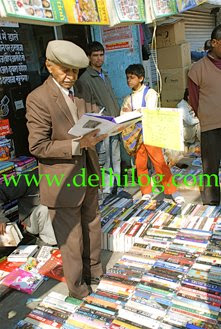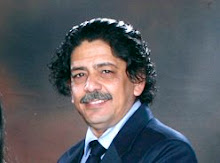 2
comments
|
Saturday, February 23, 2008
2
comments
|
Saturday, February 23, 2008


Chandni Chowk, Paharganj, Karol Bagh, Sadar Bazaar are the four most crowded and famous markets of Delhi. But one of these is out of place in this group. If you ask a delhiite which one is it, he would tick Paharganj. And if you ask a foreigner, who has been to Delhi, he too would do the same. Indeed, Paharganj has a peculiar characteristic about it which makes it very different and unique. A seedy underbelly section of New Delhi, located just opposite to the New Delhi Railway Station, Paharganj has seen a constant cavalcade of life in various stages of evolution.
Once, a suburb of the Walled City of Delhi, Paharganj finds a special mention in the mutiny papers of 1857, when it was also known by the name of Jaisinghpura and Shahganj. Muin-ud-Din Hussain Khan, a cousin of Mirza Ghalib was the Thanedar or the Head Police Officer of the Paharganj police station during that time and is supposed to have helped in saving Theophilus Metcalfe's life during the uprising, by sheltering him in Paharganj. That was the period when the Mughal dynasty in India was on the decline and the British empire was strengthening it's foothold in the country. In 1920, when Lutyen was assigned to build New Delhi, Paharganj saw a facelift of sorts. Imperial Theatre, an archaic landmark in the vicinity of Paharganj, was built in 1930.
Paharganj saw the bloodiest Hindu-Muslim riots during the partition of India in 1947 - a metamorphosis for Paharganj - with one community forced to desert it's roots and flee to Pakistan and the other fled from Pakistan to make a new beginning here. The refugees from Pakistan (mostly Punjabis) were allotted shops in Paharganj. With the dire need of making a fresh start many took up the business of eatery and soon became famous for their products. Some of the famous names established since 1947-48 in the business of eatery are still doing brisk business even when the third generation has taken over. 'Pehalwan da Hotel' (earlier known as (Pehalwan da Dhaba) and 'Sitaram Diwan Chand' (popularly known as Sitaram Bhaturewala) are the two names in particular which almost every Delhiite is aware of.

Paharganj saw another sea change in the early 70s, when 'hippieism' took over the world by storm. The convenience of being in proximity to the New Delhi Railway Station and it's accessibility to Cannaught Place, Paharganj became famous with the foreigners who travelled on a shoe string budget. Many dingy and small time hotels mushroomed in Paharganj to cater to the bohemian lifestyle of these foreigners. And as a
 complement to the theory of 'demand and supply' several shopkeepers changed over to the business of tour operators, travel agents and PCOs with STD and ISD facilities. Keeping pace with the changing times, now internet cafes have also come up in abundance. Paharganj is the only market in the city of Delhi, where the internet cafes are open 24 hours. A number of hotels like Hotel Namaskar, Major's Den, Hotels Vivek and Vishal have found a mention of credence in the prestigious 'Lonely Planet'; and so have some eating joints. One of the most sought after eating joints is the German Bakery, Khosla Cafe and Sam's Cafe.
complement to the theory of 'demand and supply' several shopkeepers changed over to the business of tour operators, travel agents and PCOs with STD and ISD facilities. Keeping pace with the changing times, now internet cafes have also come up in abundance. Paharganj is the only market in the city of Delhi, where the internet cafes are open 24 hours. A number of hotels like Hotel Namaskar, Major's Den, Hotels Vivek and Vishal have found a mention of credence in the prestigious 'Lonely Planet'; and so have some eating joints. One of the most sought after eating joints is the German Bakery, Khosla Cafe and Sam's Cafe.
 With the influx of foreign tourists, the vices connected with the tourism industry inevitably crept in with this changeover. But a stern and constant vigil by the police has always kept them under check.
With the influx of foreign tourists, the vices connected with the tourism industry inevitably crept in with this changeover. But a stern and constant vigil by the police has always kept them under check.Presently, Paharganj is a picture depicting a 'mini-world'. Tourists of different nationalities mingle conveniently with each other. Language does not seem to be a barrier here. Foreigners express their demands and requirements in broken Hindi from the phrases they have crammed from various tourist guides and studied them intensively over a short period of time just before reaching India. The illiterate hotel boy conveniently and convincingly talks in broken English and at times even in French, German, Spanish (!!!) that he has picked up during his acquaintance with various tourists.
The traffic scene on the road of the main bazaar of Paharganj presents a scene of a whole and undivided integrity of all sorts of modes of transport. Bullock carts compete with the latest models of Honda Citys and Opel Astras, sharing the road with cyclists and jaywalkers - making no fuss about it.
Now, an interesting piece of information which is sure to raise everyone's eyebrows ! In 1982, JFK Jr. the son of John F Kennedy, former President of USA, stayed in Paharganj in a run down dingy hotel called Shivalik Lodge. He had to write a paper on the functioning of Indian democracy, while studying at Brown University for his graduation. He kept his identity discreet to avoid to gain an advantage of his status. So much so that even the owner and staff of the lodge didn't know who he was. Now, isn't that interesting ?
Labels: delhi, delhi tourism, German Bakery, hindi films, Honda City, JFK, Karol Bagh, Lonely Planet, New Delhi Railway Station, Opel Astra, paharganj, Police, Walled City














